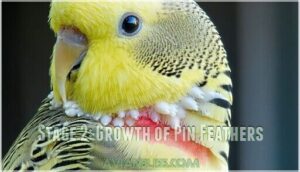This site is supported by our readers. We may earn a commission, at no cost to you, if you purchase through links.

You’ll notice scattered feathers around their cage and see your feathered friend looking a bit scruffy as old feathers fall out. This natural process typically happens during spring or fall when seasonal changes trigger their body’s renewal cycle.
Most budgies take about 6-8 weeks to complete their molt, though some may stretch it longer. While molting, your budgie might seem less active and slightly grumpy – think of it like having a bad hair day that lasts for weeks.
Understanding the stages and proper care can make this transformation smoother for both you and your bird, as it involves a natural process of renewal, helping your budgie go through a transformation with minimal stress, and ensuring you provide the right environment for a healthy renewal cycle, which is crucial for their well-being during this molting period.
Table Of Contents
- Key Takeaways
- Normal Budgie Moulting
- Abnormal Budgie Moulting
- Stages of Budgie Moulting
- How to Care for a Moulting Budgie
- Frequently Asked Questions (FAQs)
- How long does a budgie molt last?
- How often do budgies molt their feathers?
- Why do budgies molt?
- What do budgies look like when molting?
- Is molting seasonal for budgies?
- What happens if a budgie molts?
- How Long Does the Molting Process Typically Last for Budgies?
- How long does the molting process typically last for budgies?
- Can budgies molt multiple times per year?
- Do male and female budgies molt differently?
- Conclusion
Key Takeaways
- Your budgie will molt once or twice yearly, starting around six months of age – this natural process typically happens during spring or fall, when seasonal changes trigger their body’s renewal cycle.
- Normal molting lasts 6-8 weeks with predictable signs – you’ll notice scattered feathers around the cage, your bird looking scruffy, increased preening, and pin feathers emerging in a symmetrical pattern.
- You can distinguish normal from abnormal molting by watching for warning signs – rapid feather loss, bleeding feathers, excessive preening causing damage, or complete molting cessation require immediate veterinary attention.
- Proper care during molting includes high-quality nutrition and comfort measures – provide protein-rich foods, maintain consistent temperatures between 70-75°F, offer gentle bathing options, and practice gentle handling to support your bird through this challenging time.
Normal Budgie Moulting
You’ll notice your budgie shedding feathers and growing new ones during molting season, which happens once or twice a year.
This natural process typically starts around 3-4 months of age and continues annually, triggered by changes in daylight hours and seasonal shifts.
Signs of Normal Budgie Moulting
Several telltale signs indicate your budgie’s entering a normal molt cycle.
Your budgie’s about to look like a feathered tornado hit—perfectly normal during molt season!
You’ll notice feather loss scattered across the cage floor, creating what looks like a tiny pillow explosion.
Your bird might appear scruffy or disheveled as old feathers shed.
Watch for these key budgie molting signs:
- Increased preening – Your bird becomes obsessed with grooming, like a teenager getting ready for prom
- Pin feathers emerging – Small, white tubes with pinkish bases appear where new growth starts
- Mild behavior changes – Your usually social budgie might seem grumpier or more withdrawn
Normal parakeet molting symptoms include symmetry of loss, meaning feathers drop evenly on both sides.
You’ll spot bald patches temporarily, but new plumage grows systematically.
The molting symptoms follow a predictable pattern, starting with head and neck feathers before progressing to wings and tail.
Causes of Normal Budgie Moulting
Now that you’ve spotted those telltale signs, let’s explore what actually triggers your budgie’s molting cycle.
Understanding these natural causes helps you support your feathered friend through this important process.
Your budgie’s molting isn’t random—it’s driven by several natural factors that work together like clockwork:
- Daylight hours and photoperiods – Changes in natural light cycles signal your budgie’s body when it’s time to molt
- Temperature effects – Seasonal shifts in warmth trigger hormonal changes that start the molting process
- Hormonal influence – Your budgie’s pituitary and thyroid glands release hormones that control feather replacement
- Age variations – Younger budgies molt more frequently as their bodies grow and develop
- Seasonal changes – Spring and fall naturally prompt molting cycles in most healthy budgies
These molting triggers work together to help your budgie stay healthy with fresh, strong feathers for flight and temperature regulation.
It’s also normal for budgies to experience slight weight fluctuations during this time.
Abnormal Budgie Moulting
While normal molting happens on a predictable schedule, abnormal molting can catch you off guard and signal underlying health issues.
You’ll want to recognize the warning signs early so you can help your feathered friend get back on track.
Signs of Abnormal Budgie Moulting
Abnormal budgie molting disrupts your bird’s natural feather cycle, creating concerning patterns you shouldn’t ignore. Unlike gradual seasonal changes, these issues demand immediate attention and often signal underlying health problems.
It’s essential to provide proper nutrition, especially protein, as it greatly supports healthy feather growth.
Watch for these warning signs:
- Rapid feather loss with sudden bald patches appearing overnight
- Bleeding feathers or damaged pin feathers that won’t heal properly
- Excessive preening leading to self-inflicted feather damage and stress
Feather deformities and molting cessation also indicate serious problems requiring veterinary advice immediately.
Causes of Abnormal Budgie Moulting
When nutritional deficiencies strike your budgie’s diet, abnormal molting patterns can emerge like unwelcome guests.
Poor nutrition disrupts natural feather growth, creating bald patches and uneven shedding that’ll leave your bird looking disheveled.
Several factors trigger these concerning changes:
- Nutritional deficiencies – lack of protein, vitamins, and minerals essential for healthy feather development
- Environmental stressors – temperature fluctuations, poor lighting, or overcrowded conditions that disrupt natural cycles
- Underlying diseases – viral infections like French molt or genetic factors that compromise feather production
Hormonal imbalances from breeding stress can also cause irregular budgie molting.
The process of molting, involving the shedding of old feathers, typically lasts six to eight weeks.
These disruptions create a domino effect, where one issue compounds another, making your feathered friend’s natural molting process go haywire.
Stages of Budgie Moulting
Understanding budgie molting becomes easier when you know the three distinct stages your feathered friend goes through.
Each stage brings its own changes, from the initial feather loss to the final emergence of beautiful new plumage.
Stage 1: Loss of Feathers
Your budgie’s molt begins with the Initial Signs of feather loss, typically starting around the head and neck area.
This natural process involves Symmetrical Loss, where feathers drop from both sides of your bird’s body to maintain balance.
You’ll notice Feather Shedding accelerating as the Molt Start progresses, with small downy feathers appearing around the cage floor.
The parakeet losing feathers phase affects their confidence during flight, making them more cautious about flying.
This budgie feather loss stage can last several weeks, with budgie molting creating a somewhat scruffy appearance as gaps appear in their plumage.
Stage 2: Growth of Pin Feathers
After feathers fall out, your budgie enters the pin feather stage. These tiny spikes emerge like miniature porcupine quills, wrapped in protective keratin sheaths. Pin feathers appear white with pinkish tones and sometimes black tips. They’re nature’s way of protecting new growth during feather development stages.
Your bird will experience increased itchiness and preening as these pinfeathers push through the skin. The feather development rate varies, but most pin feathers emerge within days of old feather loss.
Here’s what to watch for during this budgie molting stage:
- Pin feathers feel rough and spiky to touch
- Your bird preens more frequently to manage discomfort
- Sheath removal ease improves as feathers mature
- Feather growth progression stages become visible daily
- Pin feather damage can occur if sheaths break prematurely
Resist helping with sheath removal – your budgie knows when they’re ready to come off naturally.
Stage 3: Growth of Full New Feathers
The final stage brings the most satisfying transformation—your budgie’s pin feathers mature into stunning, fully-formed plumage.
As keratin sheaths break away through natural preening, vibrant new feathers emerge with improved flight readiness and enhanced coloration.
This feather development marks your bird’s return to peak condition, signaling the completion of budgie molting stages and readiness for post-molt care.
Ensuring proper hydration is essential during this final stage to support ideal feather health.
How to Care for a Moulting Budgie
When your budgie starts molting, you’ll need to step up your care game to help them through this challenging time.
Proper nutrition and comfort measures make all the difference in ensuring your feathered friend stays healthy and stress-free during their feather renewal process.
Adopt a High-quality Nutritional Diet
Your budgie’s body works overtime during molting, demanding more nutrients than usual.
Protein sources like cooked eggs and sprouted seeds become essential for strong feather growth. Vitamin supplements support immune function while mineral intake guarantees proper feather structure.
Don’t forget hydration importance—fresh water helps nutrient absorption. A balanced diet with varied budgie nutrition meets all dietary requirements better than seeds alone.
A specialized diet can help with budgie feather regrowth.
Improve Comfort
When your budgie’s molting, creating a comfortable environment becomes your top priority for budgie molting care.
Here’s how to minimize stress and reduce itchiness:
- Maintain consistent temperatures between 70-75°F to keep your feathered friend cozy
- Offer gentle bathing techniques like shallow dishes or light misting for molting support
- Practice gentle handling by limiting interactions when they’re feeling prickly
These budgie care tips help create the perfect molting sanctuary where your bird feels secure and supported.
A balanced diet is important, so offer protein-rich foods during this time.
Frequently Asked Questions (FAQs)
How long does a budgie molt last?
A typical budgie molt lasts 2-8 weeks, depending on your bird’s age, health, and environment.
You’ll notice gradual feather replacement starting with head feathers, then progressing to body, wing, and tail feathers throughout this period.
How often do budgies molt their feathers?
Like clockwork from the telegraph era, your budgie’s molting schedule follows a predictable pattern.
Most budgies molt once or twice yearly, with younger birds molting more frequently than adults due to their rapid growth needs.
Why do budgies molt?
Your budgie molts to replace worn-out feathers with fresh ones, maintaining healthy flight capabilities, proper insulation, and vibrant appearance.
This natural process keeps your bird’s plumage in peak condition for ideal health.
What do budgies look like when molting?
Molting makes your budgie look messy and scruffy.
You’ll notice patches of missing feathers, especially around the head and neck first.
Pin feathers appear as small, white tubes with dark tips emerging from the skin, which can be a key indicator of molting.
Is molting seasonal for budgies?
Wild budgies usually molt in spring and fall, but your pet budgie can molt anytime throughout the year. Indoor lighting and temperature changes affect their natural seasonal patterns.
What happens if a budgie molts?
Your feathered friend becomes a living tornado of falling feathers.
You’ll see them shed old plumage while growing fresh, vibrant new feathers.
They’ll preen constantly, appear scruffy temporarily, and may feel itchy during this natural renewal process.
How Long Does the Molting Process Typically Last for Budgies?
Your budgie’s molting process typically lasts 2-8 weeks, depending on their age, health, and environment.
You’ll notice they shed old feathers gradually and grow fresh ones to keep their flight and insulation at their best.
How long does the molting process typically last for budgies?
Your feathered friend’s makeover marathon typically lasts 2-8 weeks, though some fashion-forward budgies wrap up their wardrobe refresh in just 2-3 weeks depending on their health and age.
Can budgies molt multiple times per year?
Yes, your budgie can molt multiple times per year.
Most budgies molt once or twice annually, though some experience 2-4 molts yearly.
Young budgies molt more frequently than adults, with timing influenced by daylight, temperature, and individual biology, and this process can be considered a complete concept in understanding budgie molting patterns.
Do male and female budgies molt differently?
Female budgies typically experience longer or more pronounced molts due to hormonal fluctuations, while males generally have more predictable molting patterns.
However, individual variations exist based on age, health, and environmental conditions, which can also impact the molting patterns.
Conclusion
Understanding when do budgies molt saves you from unnecessary panic attacks when your feathered friend starts looking like they’ve been through a wind tunnel.
Your budgie’s molting schedule follows predictable patterns – typically once or twice yearly around six months of age, triggered by seasonal changes.
By recognizing normal versus abnormal molting signs, supporting them through each stage with proper nutrition and comfort, you’ll help guarantee their transformation stays healthy and stress-free.
- https://budgiefly.com/why-are-your-budgies-losing-feathers/
- https://www.reddit.com/r/petbudgies/comments/15ut23r/how_often_does_your_budgie_moult/
- https://en.wikipedia.org/wiki/Moulting
- https://www.encyclopedia.com/plants-and-animals/zoology-and-veterinary-medicine/zoology-general/molting
- https://vcahospitals.com/know-your-pet/molting-in-birds









